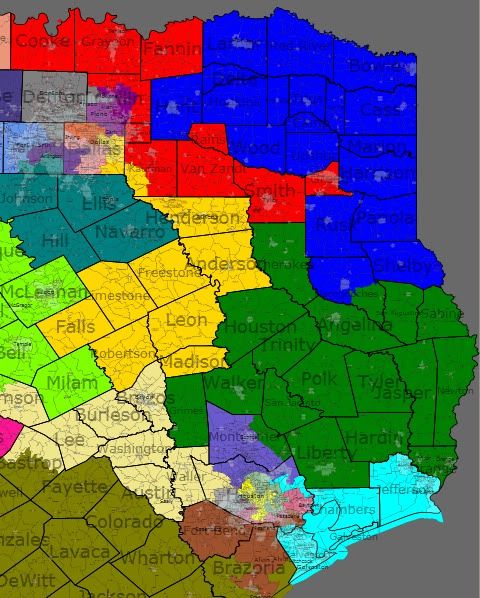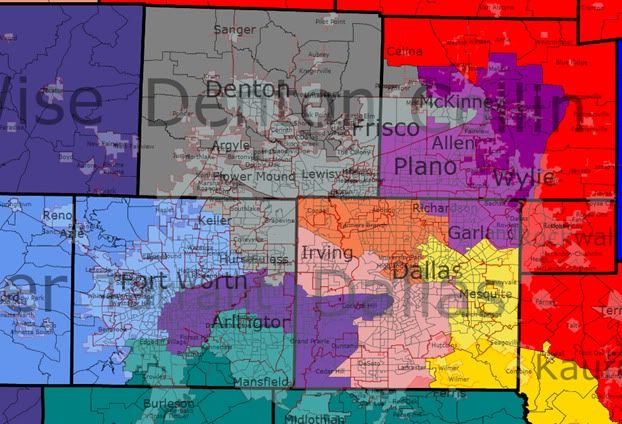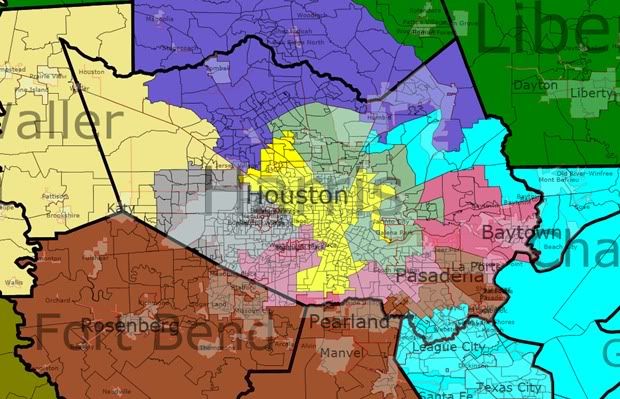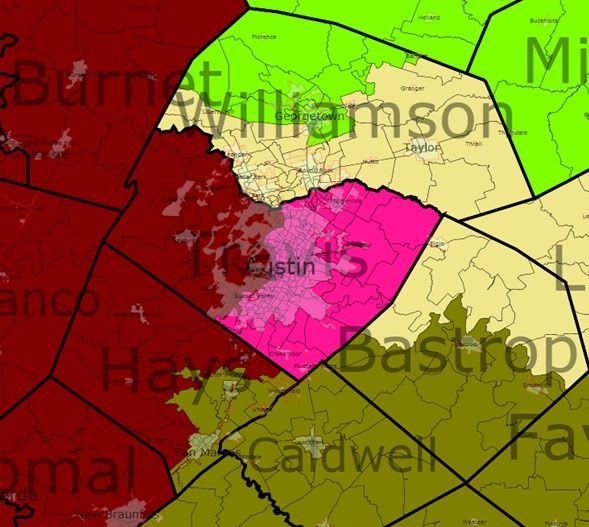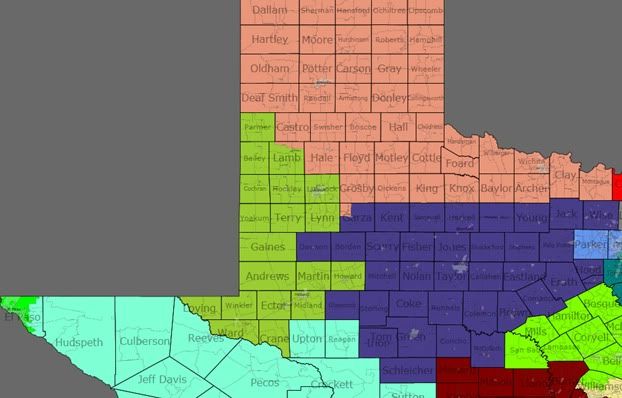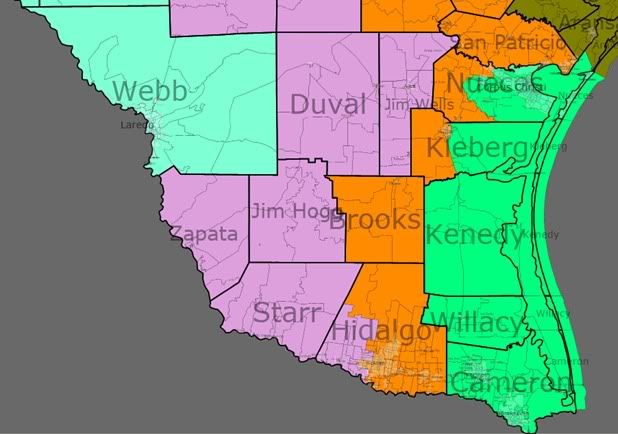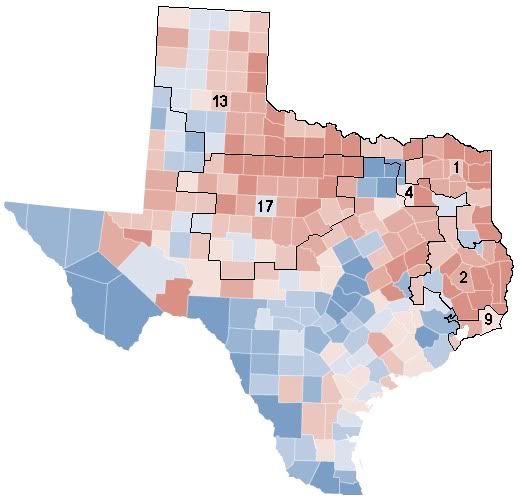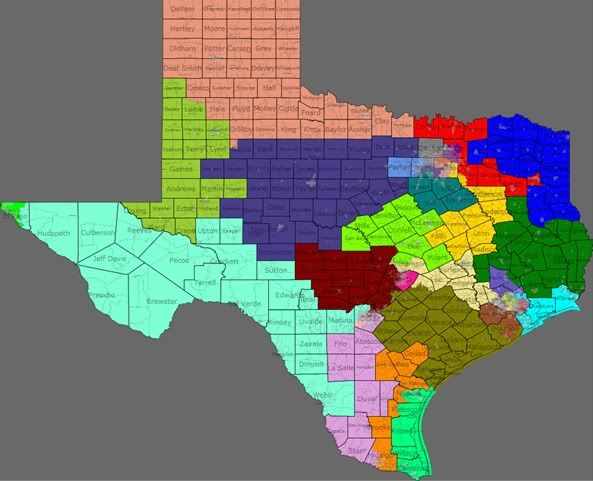The 1984 Presidential election was the first in which I tracked regional election returns, so now that we’re nearly a quarter century removed from the Reagan-Mondale election, I thought it would be fun to count up 20 American cities of varying sizes that have changed the most politically over that timespan. And boy have there been a ton of changes…so much so that it was difficult to narrow my sample size to nearly 20. The good news is that of the 20 selected, 13 of the cities have been trending more Democratic, and most of the nation’s significant metropolitan areas have trended most dramatically blue while it’s generally small, zero-growth cities (along with large swaths of rural America) that have been trending red. More below the fold….
Now clearly there are some major metro areas that have trended strongly blue that didn’t make the cut here. The most significant are the two largest, New York City and Los Angeles. In the case of New York City, the Democratic Party’s growth hasn’t been as statistically dramatic as many of its peers. And in the case of metropolitan Los Angeles, the Democratic trendline has been fairly erratic, particularly in the fast-growing Riverside-San Bernardino region which backslid towards the Republicans in 2000 and especially 2004 before returning to the Democrats in 2008. Most of the towns on my list have experienced a fairly steady shift in the political trendline since 1984. Anyway, in descending order…
20. Muskogee, Oklahoma….The caricature of Muskogee will eternally be connected to the flag-waving Merle Haggard song of the Vietnam War era, contrasting the God-fearing patriots of Muskogee with the disrespectful coastal “hippie” culture. At least as far as political affiliation goes, Muskogee didn’t quite live up to that caricature, being a fairly reliable redoubt for Democrats for decades, even “wimpy liberals” like Michael Dukakis and Al Gore who lost Oklahoma statewide by double digits. But the 2000 election was the last hurrah for Democrats in Muskogee as Rovian culture war politics caught up to them and resulted in a shift of partisan allegiance this decade. Bush beat Kerry comfortably in 2004 and McCain trounced Obama by 15 points in Muskogee County this year, completing the realignment. All is not completely lost though, as Muskogee County was one of only four Oklahoma Counties to vote against Jim Inhofe this year.
19. Jackson, Mississippi….Since Mississippi has never been a swing state and thus doesn’t get any serious media scrutiny in Presidential elections, it’s been easy to miss the political transformation of its largest city into a huge Democratic stronghold. Hinds County, home of the majority of the Jackson metro area, was almost as Republican as Mississippi at large in the Mondale and Dukakis elections, but began moving gradually towards Democrats during the Clinton years and finally becoming a huge Democratic city this decade, with escalating margins of victory for both Gore and Kerry and then a more than 2-1 rout of Obama over McCain in 2008. I’m sure the black vote has grown substantially as a percentage of Hinds County’s overall electorate, with much of the white vote moving east to Rankin County, which has remained staunchly Republican over the past two decades. Nonetheless, metropolitan Jackson, MS, has moved substantially towards Democrats in the last quarter century.
18. Columbia, South Carolina…My writeup about Jackson, MS, could almost be cut-and-pasted to describe the trajectory of Columbia, South Carolina, since the Reagan-Mondale election, specifically Richland County, the county that’s home to the city of Columbia. It started its leftward march during the Clinton years and finished this election cycle going nearly 64% for Obama. Again, the county that can be best described as “suburban” Columbia (Lexington County) has trended Republican over the same time period suggesting racial polarization is likely in play, but the Republican growth in Lexington County has not kept pace with the Democratic growth of Richland County.
17. Beaumont-Port Arthur-Orange, Texas….The southeast corner of Texas has long been a reliable Democratic bastion, with a fairly large black population working in tandem with a Yellow Dog Democrat instinct among the area’s white voters. Back in 1984, the cluster of three counties in the state’s southeast corner all went for Mondale, in sharp contrast to Texas at-large and the United States at-large. The region’s lesser populated counties, Orange and Newton, were the first to transform in the wrong direction, with Orange going red after the Clinton years and Newton barely hanging on for Gore in 2000. With its larger black population, Jefferson County, the largest of the three counties, has hung on for Kerry and Obama with ever-shrinking margins, to the point that Obama won by merely two points in the county this year. Meanwhile, Orange and Newton Counties both went for McCain by startling 2-1 margins.
16. Raleigh-Durham-Chapel Hill, North Carolina….The Raleigh-Durham area has always been the most Democratic population center of North Carolina, but the region’s population as a share of the state at-large and its Democratic margins have progressively grown since 1984 (when only Durham and Orange Counties narrowly went Mondale). As a result, the region is most responsible for rapidly changing North Carolina from a Republican stronghold 10 years ago to an Obama state in 2008, and if Wake County (Raleigh, Cary) continues its leftward trendline, portends an even bluer future for North Carolina.
15. Lake Charles, Louisiana….Two positions up on the list I profiled Beaumont, Texas, and its shift away from Democrats since 1984. Only about half an hour to its east is another small city in the Louisiana bayou that has become a tough slog for Democrats, at least in Presidential elections. Twenty-point national loser Walter Mondale lost Calcasieu County (home of Lake Charles) by the slimmest of margins in 1984, but Democrats handily prevailed in three subsequent Presidential elections before the bottom started falling out in 2000. Republican margins escalated in 2004 and 2008, where McCain prevailed by 25 percentage points in the county. Race was almost certainly a factor in the size of Obama’s trouncing here, but it’s hard to imagine any Democratic Presidential candidate being able to win in Lake Charles nowadays.
14. Burlington, Vermont….In 2008, the state of Vermont was second only to Hawaii in its margin of victory for Barack Obama and has a reputation as one of, if not the most, liberal states in America. Hard to imagine that up until 1992, Vermont was the most Republican state in America from a historical perspective, being the only state to never have voted for FDR. Things changed fast in the Clinton years, and Burlington, the largest city in Vermont (using the term “city” very loosely), is metaphorical for the entire state’s wholesale dismissal of the Republican Party over the last two decades. Chittenden County (Burlington) went for Barack Obama by more than 70% this year. Quite a contrast for a place that stubbornly embraced Alfred Landon and Wendell Willkie rather than voting for Franklin Roosevelt.
13. Chicago, Illinois….In 1984, Walter Mondale carried Cook County, home of the city of Chicago and another two million residents of suburban Chicago, by less than three percentage points. Meanwhile, all of the suburban and exurban counties surrounding Chicago (Du Page, Lake, Will, McHenry, Kane) went for Reagan by 2-1 margins. A similar, if slightly less dramatic, formula emerged in 1988. It was a formula in which Republicans were able to eke out victories of narrow to modest proportions in the state of Illinois. But starting with the Clinton years, the calculus changed. Democratic margins in Cook County grew, while margins in the suburban-exurban counties began to shrink a little more with every election cycle, so much so that long-time Du Page County Congressman Henry Hyde has his first quasi-scare in 2004. In 2008, a favorite son was on the ballot and threw the curve a little bit, but the trendline still seems to hold. Nowadays, the Democratic performance in metropolitan Chicago is so consistently dominating that even landslide GOP victories downstate aren’t enough to put Republicans in the game, as witnessed in 2004 when John Kerry won only 15 of Illinois’ 102 counties, yet still won the state by double digits due to his 40-point landslide in Cook County.
12. Columbus, Ohio…..Up until the last 10 years, the Columbus area was far closer politically to the Cincinnati metro area than the Cleveland metro area, going strongly for Reagan and Bush-41 and even backing Bush-41 over Bill Clinton in 1992, but significant demographic shifts have moved Columbus dramatically to the left, starting with Gore’s surprise (at least to me) narrow victory in the 2000 Presidential election. That half-point margin of victory for Gore grew to nine points in 2004 and nearly 20 points in 2008, providing Democrats a desperately needed counterweight to the Appalachian region of southern Ohio which has been trending against them in the same time period. Columbus’ exurban counties remain Republican, but there are signs that margins are beginning to shrink even there.
11. Paducah, Kentucky….There’s a cluster of territory in western Kentucky and southern Illinois that seems to be politically similar, with a long-standing Yellow Dog Democrat leaning that held on through the 1980’s and 1990’s. Neither Mondale nor Dukakis won McCracken County, home of Paducah, but both fell short by less than ONE-HALF of one percentage point versus Reagan and Bush-41, respectively. Clinton won there comfortably in 1992 and 1996, as he did in most of the rural areas surrounding Paducah on both the Illinois and Kentucky side of the Ohio River. But for reasons I don’t really have a handle on, the tide turn dramatically in 2000 and has continued sweeping Republicans into office since by growing margins. McCain beat Obama by more than 25 points in McCracken County in 2008. And unlike some other Yellow Dog Democrat regions that continue to perform well for some downballot Democrats, Paducah has turned against the party almost completely, even rejecting Dan Mongiardo and Bruce Lunsford in recent Kentucky Senate elections.
10. Miami-Fort Lauderdale-West Palm Beach, Florida….I tend to consider Florida’s Gold Coast region one single metro area despite the significantly different demographics in the northern and southern halves of the area. The entire region leaned Republican in the 1980’s. Neither Mondale nor Dukakis was able to win Palm Beach or Broward Counties, and both lost big in Miami-Dade County. The area trended strongly blue in the 1990s and especially 2000, where the presence of Jewish Vice-Presidential nominee Joe Lieberman helped run up the score to blistering margins for Gore in Palm Beach and Broward Counties. While Democratic margins in those two counties have stalled and even backslid slightly in 2004 and 2008, the Miami-Dade area has picked up the slack and continues its 25-year trendline from a Republican stronghold to a Democratic stronghold.
9. Philadelphia, Pennsylvania…..Metropolitan Philadelphia was much like Chicago in the 1980s in that the city was staunchly Democrat but the suburban areas were uncontested Republican strongholds populated by affluent Reagan-era yuppies. But like Chicago, the last decade has seen the city grow even more Democratic while the suburbs, on the Pennsylvania, New Jersey, and Delaware sides, have become less Republican. And that’s the only difference between suburban Chicago and suburban Philadelphia. Philly’s suburbs have not only become less Republican, they’ve become outright Democratic. This year, with far-flung exurban centers like Chester and Berks Counties in Pennsylvania turning an Obama shade of blue, the realignment has been complete, and necessary to help offset shrinking Democratic margins in the western part of Pennsylvania.
8. Gadsden, Alabama….While Alabama has not recently been associated with significant numbers of Yellow Dog Democrats the way that Arkansas and Tennessee have, the mostly white area north of Birmingham remained strong terrain for Democrats in the 1980s and 1990s. The most populous county among them was Etowah County, home of the small northern Alabama city of Gadsden. Mondale and Dukakis lost the county by microscopic margins (less than half a point) but Clinton went on to win twice in the 1990s. But it was clear by Clinton’s scant three-point margin in 1996 that times were changing in Gadsden. And change they did, with Bush prevailing comfortably in 2000 and Republicans growing margins significantly in 2004 and 2008, with McCain ultimately prevailing with an astounding 69% margin. I think it’s a pretty safe bet that Gadsden, Alabama, will not be returning to the Democratic fold in the foreseeable future.
7. Reno-Sparks-Carson City, Nevada….While there has been a tremendous shift towards Democrats in Las Vegas over the past few decades, a more recent and more dramatic political realignment has played out a few hours up the road in Reno. Northwestern Nevada reliably churned out margins better than 2-1 for Republicans in the 1980’s and continued going red even during the Clinton years, but the first signs of softening emerged in 2000 when Washoe County went Bush by “only” 10 points. Four years later, John Kerry spent a lot of time and money in Reno to try to turn Nevada blue, and managed to shrink Bush’s margin from 10 points to four points. This year, Reno finally made the leap to the Democrats with margins so lopsided that it’s hard to believe it was ever Republican in the first place (13 points for Obama in Washoe County and even a narrow victory in Carson City).
6. Denver-Boulder, Colorado…..Walter Mondale got destroyed everywhere but the city of Denver in 1984, but from that point forward, there were pockets of Democratic strength in metropolitan Denver, specifically Boulder County and the northern Denver suburbs of Adams County. Nonetheless, the rapidly growing suburban enclaves of Jefferson and Arapahoe Counties remained unwaveringly red even during the Clinton years and it was starting to appear as though Colorado would join the rest of the Rocky Mountain West in “safe Republican” territory. By 2004, college students in Boulder had consolidated behind Democrats in a way that hadn’t been the case in the recent past while GOP margins began noticeably softening in the affluent suburbs. The transformation was completed in 2008 when most of those suburbs went comfortably for Obama (and Senate candidate Mark Udall), leaving virtually every corner of the Denver metropolitan area except the far southern exurbs of Douglas County painted blue.
5. Steubenville-Weirton, Ohio and West Virginia….One of the most difficult to understand political transformations of the last decade has been the shift of this dying, unionized steel region of eastern Ohio and northern West Virginia towards Republicans. With the exception of Flint, Michigan, you’d be hard-pressed to find a population center in the country as economically devastated as the twin towns of Steubenville and Weirton, and the locals have responded by…..voting Republican. I was first struck by the soft numbers Gore pulled in the region in 2000 and thought it was a fluke….culturally conservative Appalachian voters weary of the Clinton years and responding favorably to a “compassionate conservative” from Texas. For that reason, I expected John Kerry’s biggest growth zone in the key battleground state of Ohio in 2004 would be the area around Steubenville, St. Clairsville, and East Liverpool, especially since Weirton Steel went broke in 2001 and the metro area had the highest loss of jobs of any place in the nation during Bush’s first term. Boy was I wrong. Kerry underperformed Gore in the area, and quite significantly. In 2008, McCain won by double digits on the West Virginia side and Obama held on by a mere 50 votes in Jefferson County, Ohio (Steubenville). Hard to see how the trendline reverses from where we are now.
4. Pittsburgh, Pennsylania….Most political aficianadoes would easily identify the San Francisco Bay Area as the nation’s most Democratic major metropolitan area, but throughout the 1980s and early 1990s, Pittsburgh had it beat. Every county in and around Pittsburgh voted comfortably for Mondale and Dukakis in 1984 and 1988. The margins seemed to peak in 1992 and then showed serious erosion in 1996. Clinton won significantly fewer votes than he did in 1992 while Bob Dole won more votes than did George Bush in 1992, defying the nation trendline. In 2000, Gore prevailed by even weaker numbers and lost Westmoreland County east of Pittsburgh, a county that had voted for Mondale 16 years earlier. The metro-wide erosion continued for Kerry in 2004 and hit bottom in 2008, with Obama winning only Allegheny County in metropolitan Pittsburgh, losing Beaver County where Dukakis had won by a more than 2-1 margin in 1988, and getting trounced by 17 points in the former Mondale county of Westmoreland. It would appear that cultural conservatism and diminished association with a unionized past is taking its toll in the Pittsburgh area much like the Steubenville-Weirton area a short drive down the Ohio River.
3. San Francisco Bay Area, California….It’s hard to believe that in 1984, only San Francisco, Alameda, and Marin Counties in the Bay Area voted for Walter Mondale, given how lopsidedly Democratic every county in the area is today. The Bay Area officially surpassed Pittsburgh as the nation’s bluest major metropolitan area in the 1996 election, and the margins have only continued to grow since then to the point that Solano County in the region’s northeastern fringe was the region’s LEAST blue county in 2008. Obama only won there by 63%! Meanwhile the core old-line cities of the Bay Area (San Francisco, Oakland) are both supporting Democrats by more than 80% margins and the Silicon Valley regions of the southern Bay Area voted for Obama by 70% margins. For anyone that may know, is there a single city, distant suburb, or small town in the Bay Area that voted McCain in 2008?
2. Orlando, Florida…..Florida was a very crimson shade of red in the 1980s Presidential elections, but the Orlando area was even redder than the state average back then. Orange County, where the city and the core of the Orlando metro area are located, held strong even for Bob Dole in 1996 before narrowly making the leap to Gore in 2000, joining Osceola County (Kissimmee) just to its south. While the area stagnated for John Kerry in 2004, I think its fair to say everybody was blown away by how deep a shade of blue the Orlando area turned this year for Barack Obama, taking Orange and Osceola Counties by nearly 20 points and falling only three points short in the northern suburban Seminole County, a long-standing Republican stronghold. Considering that Obama’s performance in the Tampa-St. Petersburg and West Palm Beach-Fort Lauderdale regions of Florida only barely overperformed Gore and Kerry, it’s not an exaggeration to say that the Orlando area margins were the margin of difference for Obama in Florida this year.
1. Washington, D.C……We all know that the District of Columbia is the nation’s most Democratic jurisdiction and has been for decades now. At least in the last two Presidential elections, there has not been a single U.S. county in any of the 50 states that has gone Democratic by as wide of margin as the District of Columbia. But the real story is the reach of the D.C. area that has already transformed the political climates of two states and could end up changing a third in the foreseeable future. The state of Maryland was the first to change. Prince George’s County was always Democratic even during the Reagan years, but nothing approaching the 89% margin of victory that Obama scored there in 2008. The transformation of Montgomery County into a nearly 3-1 Democratic stronghold, along with the more recent transformation of exurban Charles County, until 10 years ago a Republican stronghold, have helped make the state of Maryland an almost impenetrable fortress of Democratic Party might. And in the last few years, the D.C. area has extended its political muscle into the state of Virginia. The first signs of Democratic life came in 2000 in Fairfax County when Bush underperformed Bob Dole’s performance four years ago and barely eked out a victory. Fairfax County was soon conquered, and soon after, Democrats managed to turn exurban outposts like Prince William and Loudoun Counties blue, a feat that would have been unthinkable in 2000. But even with Maryland and Virginia on a strong blue trendline, the reach of the Washington, D.C. area still hasn’t been fully realized. The next state that could be turned is West Virginia. In the northeast corner of West Virginia, the state’s fastest-growing county (Jefferson County, an extension of exurban DC) turned blue this year by an impressive five-point margin. Hard to imagine how the D.C. metro area can improve upon this in subsequent elections, but I continue to be awed every four years.
Any cities or metro areas I’m overlooking? I’d love to hear supportive or contrarian thoughts.
